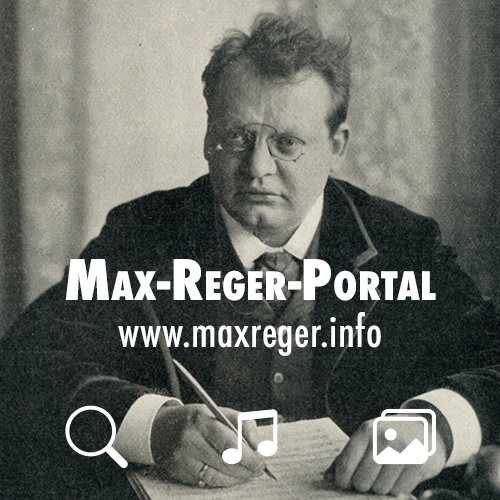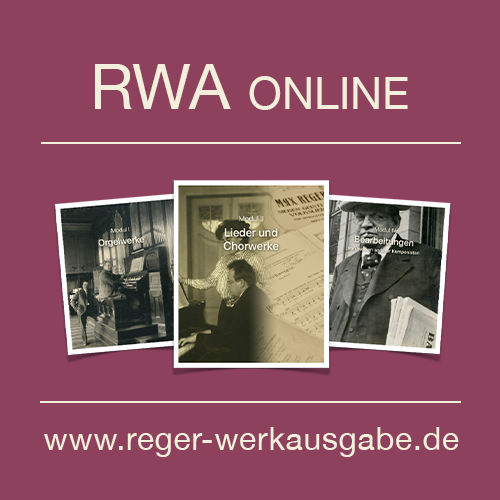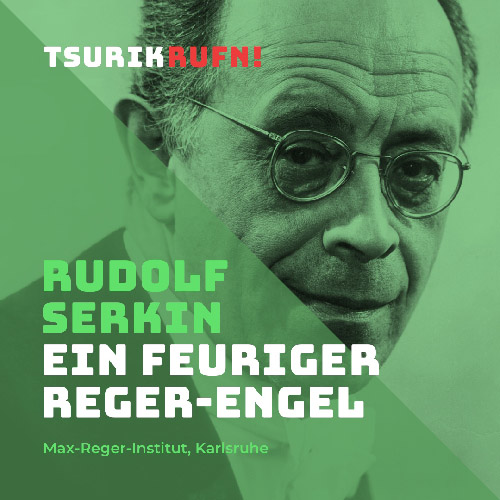At the time of its founding, the Max-Reger-Institut held no archival or financial resources. In fact, after Elsa Reger’s death the institute did not inherit any single manuscript or other Regeriana. Yet thanks to extensive research many a manuscript has come to light and has been procured for the institute, contributing to a growing number of acquisitions. This has resulted in a materially and musicologically most valuable collection documenting the entire life and work of the composer.
The archive of the Max-Reger-Institut is open to anyone interested and is used by scholars and artists from throughout the world.
Through the increased esteem of Reger – and therefore of his autograph manuscripts – donations are urgently required for the further expansion of the collection.
Music manuscripts
About one third of all currently known sources of Reger’s original compositions counting up to op. 146 and without opus number, as well as his arrangements and editions of music by others are owned by the Max-Reger-Institut – further manuscripts are located in public libraries, archives and private collections all over the world. The collection of the Max-Reger-Institut amounts to important original scores intended for printing, such as the Sinfonietta, Op. 90, the Symphonischer Prolog zu einer Tragödie, Op. 108, the Konzert im alten Stil, Op. 123, the String Quartet in D minor, Op. 74, the Piano Trio in E minor, Op. 102 as well as the String Trios, Opp. 77b und 141b. In the field of organ works, the Max-Reger-Institut owns several important manuscripts intended for the engravers (Suite in E minor, Op. 16, Variations and Fugue on an original theme, Op. 73 and Introduktion, Passcaglia and Fugue in E minor, Op. 127) but also such manuscripts that Reger created for the organist Karl Straube (Chorale Fantasias, Opp. 27, 30, 40 and 52, Fantasia and Fugue in C minor, Op. 29, Organ Sonata in F sharp minor, Op. 33, Fantasia and Fugue on BACH, Op. 46). Several further music manuscripts of diverse genres and periods of creation and a comprehensive collection of drafts and sketches complement the collection and illuminate not least Reger’s extensive activities as arranger and editor of the music of others.
Apart from these original manuscripts, the Max-Reger-Institut has been collecting photocopies or digitizations of all further relevant sources in public and private collections ever known past and present, which can be consulted alongside the institute’s original collection upon application.
-
From: German dances, Op. 10, nos. 1, 5, 6, 7, 11 (instrumentation; 8 pp.)
-
Variations and Fugue on a theme of Beethoven, Op. 86 (orchestral version; 80 pp.)
-
Sinfonietta in A major, Op. 90 (139 pp.)
-
From: Variations and Fugue on a theme of Hiller, Op. 100 (2 deleted pp.)
-
Aria, Op. 103a, no. 3, from Six Pieces, arr. for violin &. small orchestra (4 pp.)
-
Symphonic Prologue to a Tragedy, Op. 108 (76 pp.)
-
Concerto in the Old Style, Op. 123 (84 pp. + title page)
-
Pantalon, deleted 4th movement of the Ballet Suite, Op. 130 (11 pp.)
-
early Piano concerto in F minor, WoO I/4 (presumably fragment, duplicate probably made by the father; 78 pp.)
-
Symphony movement in D minor, WoO I/8 (fragment – 1902; 36 pp.)
-
Andante and Rondo for violin and small orchestra (fragment), Op. posth. 147 WoO I/10 (score 18 pp., piano score 9 pp.)
-
Cello sonata in G minor, Op. 28 (43 pp. + title page)
-
String quartet in D minor, Op. 74 (39 pp. + title page)
-
String Trio in A minor, Op. 77b (63 pp. and title page)
-
Suite in the Old Style for violin and piano, Op. 93 (24 pp. + title page)
-
Largo from the Suite in the Old Style arr. for violin and organ, Op. 93a (3 pp.)
-
Piano Trio in E minor, Op. 102 (79 pp)
-
Aria, Op. 103a, no. 3, from Six Pieces, arr. for violoncello and piano (2 pp.)
-
Prelude and Fugue in G minor for the violin alone, Op. 117, no. 2 (4 pp.)
-
Prelude and Fugue in G major for the violin alone, Op. 117, no. 5 (4 pp.)
-
Suite in G minor for viola alone, Op. 131d, no. 1 (4 pp.)
-
Sonata in C minor for violin and piano, Op. 139 (first version; 25 pp.)
-
String Trio D minor, Op. 141b (44 pp.)
-
Trio (fragment) for piano, violin and violoncello, WoO II/17 (5 S.)
-
Twelve Waltz-Caprices for piano duet, Op. 9 (42 pp.)
-
Twenty German Dances for piano duet, Op. 10 (31 pp.)
-
Seven Waltzes, Op. 11 (28 pp.)
-
Loose Leaves. [Fourteen] Small piano pieces, Op. 13 (20 pp.)
-
From the Youth. [Twenty] Small piano pieces, Op. 17 (29 pp.)
-
[Eight] Improvisations, Op. 18 (24 pp.)
-
Aquarelles. [Five] Small Tone-pictures, Op. 25 (15 pp.)
-
From: From my Diary, Op. 82, vol. III, nos. 3-6 (12 pp.)
-
Variations and Fugue on a theme of Beethoven for 2 pianos, Op. 86 (80 pp.)
-
Variations and Fugue on a theme of Mozart, Op. 132 (for piano 4h; 35 pp.)
-
A Patriotic Overture, Op. 140 (arr. for piano 4h; 17 pp.)
-
Prelude and Fugue in G minor, WoO III/2 (3 pp.)
-
Grande valse de concert »op. 378«, WoO III/3 (3 pp.)
-
Canons WoO III/4 (105 pp.)
-
Improvisation on the Waltz »An der schönen blauen Donau« by Johann Strauss, WoO III/11 (15 pp. + title page)
-
March of the convent ladies, WoO VIII/16 (1 p.)
-
Suite in E minor, Op. 16 (40 pp. + 2 title pages)
-
Chorale Fantasia on »Ein’ feste Burg ist unser Gott«, Op. 27 (27 pp. + title page)
-
Fantasia and Fugue in C minor, Op. 29 (28 pp. + title page)
-
Chorale Fantasia on »Freu dich sehr, o meine Seele!«, Op. 30 (28 pp. + title page)
-
First Sonata in F sharp minor, Op. 33 (30 + 4 pp.)
-
Chorale Fantasia on »Wie schön leucht’t uns der Morgenstern«, Op. 40, no. 1 (21 pp. + 5 pp written by Straube)
-
Chorale Fantasia on »Straf’ mich nicht in deinem Zorn!«, Op. 40, no. 2 (16 pp. + title page)
-
Chorale Fantasia on »Alle Menschen müssen sterben«, Op. 52, no. 1 (18 pp.)
-
Chorale Fantasia on »Wachet auf, uns die Stimme!«, Op. 52, no. 2 (19 pp.)
-
Chorale Fantasia on »Halleluja! Gott zu loben, bleibe meine Seelenfreud’!«, Op. 52, no. 3 (18 pp.)
-
From: Fifty-two easily practicable Chorale Preludes, Op. 67, nos. 1-51 (84 pp.)
-
Variations and Fugue on an original theme, Op. 73 (32 pp. + title page)
-
Prelude and Fugue in F sharp, Op. 82, vol. IV, nos. 1 & 2 (4 pp.)
-
Introduction, Passacaglia and Fugue, Op. 127 (41 p.)
-
Nine Pieces, Op. 129 (28 pp.)
-
from: Pieces, Op. 145, nos. 1, 3, 5, 6, 7 (27 pp.)
-
Romance in A minor, WoO IV/11, original and arrangement for harmonium (2 + 2 pp.)
-
Three Part-Songs for Soprano, Contralto, Tenor, Bass and Piano, Op. 6 (16 pp.)
-
Gesang der Verklärten, Op. 71, for five-part chorus and large orchestra (50 pp. + 3 pp. of text)
-
Die Nonnen, Op. 112, for mixed chorus and large orchestra (51 pp. + 2 title pages)
-
An die Hoffnung, Op. 124, for contralto and orchestra (full score 28 pp.; piano score 8 pp.)
-
Five Pieces for Castra Vetera, WoO V/1, Peagant for the Lower Rhine Festival, Wesel, for chorus and orchestra (full score 80 pp.; piano score for Tanz in der Mainacht 5 pp. + title page)
-
Carmen saeculare, WoO V/2 for chorus and orchestra (51 pp.)
-
Chorale Cantata »Vom Himmel hoch, da komm ich her«, WoO V/4, no. 1, for soloists, choir, 2 violins and organ (16 pp. + title page)
-
Chorale Cantata »Meinen Jesum lass ich nicht«, WoO V/4, no. 4, for soprano, choir, violin, viola and organ (12 pp.)
-
Requiem, WoO V/9, for soloists, choir and orchestra (2 movements, fragment; 38 pp. + title page, 41 pp., 1 eliminated page)
-
Gieb dich zufrieden, Op. 79f, no. 14 (2 pp.)
-
From: Ten songs for male chorus, Op. 83, nos. 1, 5, 6, 8 (23 pp. + table of contents)
-
Motet, »O Tod, wie bitter bist du«, Op. 110, no. 3 (18 pp. + title page)
-
Abendgang im Lenz, Op. 111b, no. 2, for 4-part women’s chorus (3 pp.)
-
Lob, Preis und Ehr sei Gott, WoO VI/1 (2 pp.)
-
Vater unser, WoO VI/22, for 12-part choir (fragment; 60 pp. + 1 inserted sheet)
-
Six Lieder for medium voice and piano, Op. 4 (19 pp.)
-
Five Lieder for high voice and piano, Op. 8 (11 pp.)
-
Five Lieder for voice and piano, Op. 12 (9 pp.)
-
Five Duets for Sopran, Alt and piano, Op. 14 (13 pp.)
-
Ich stehe hoch über’m See for Bass and piano, Op. 14b (9 pp.)
-
Ten Lieder for medium voice and piano, Op. 15 (21 pp.)
-
Glückes genug, Op. 37, no. 3 for voice and piano (3 pp. + 1 title page)
-
Twelve Lieder, Op. 66, for middle voice and piano (29 pp. + title page)
-
Seventeen Lieder, Op. 70, for voice and piano (53 pp.)
-
From: Simple Tunes (Schlichte Weisen) for voice and piano, Op. 76, nos. 3, 9-11, 13-22, 24, 25, 29, 30, 56 (44 pp. and table of contents)
-
Six Lieder, Op. 104, for voice and piano (16 pp.)
-
Slumbering Song, WoO VII/17, for voice and piano (1 p.)
-
Two Sacred Songs, WoO VII/30, for voice and organ. (8 pp.)
-
Slumbering Song, WoO VII/33, for voice and piano (3 pp.)
-
Sacred song, WoO VII/36 for voice and organ (2 pp.)
-
In the Morning, WoO VII/41 (1st version; 2 pp.)
-
Early lieder (duplicates by Josef Reger and others): Adagio, WoO VII/4, In ein Stammbuch, WoO VII/5, Unter der Erde, WoO VII/6, Bitte, WoO VII/7, Bettlerliebe, WoO VII/8, Lied des Harfenmädchens, WoO VII/9, Dahin, WoO VII/10, Der Traum, WoO VII/11, Gute Nacht, WoO VII/12, Du schläfst, WoO VII/13, Gebet, Op. 4, no. 1 (34 pp. + title page)
-
Bach, Passacaglia in C minor BWV 582 for organ arr. for piano 4h, Bach-B2, no. 10 (10 pp. + title page)
-
Bach, Preludes and fugues from the Wohltemperiertes Klavier arr. for organ, Bach-B3 (48 pp.)
-
Bach, Prelude and Fugue in E flat major BWV 552 for organ arr. for piano 2h, Bach-B7 (14 pp. + title page)
-
Schule des Triospiels. J. S. Bach’s 2-part Inventions arr. for 3-part organ, Bach-B8 (18 pp.)
-
Bach, Suite (in G minor) for small orchestra, arr. and instrumentated, Bach-B13 (72 pp. + title page)
-
Bach editions: Inventions, French Suites, English Suites, Toccata and Fugue etc., Italian Concerto, Fantasia in C minor, Capriccio in B flat major, Bach-H15 vols. 4, 5, 7, 10 & 11
-
Brahms, Lieder, arrr. for piano 2h, Brahms-B1, vol. 2, nos. 1–6 (14 pp.)
-
Brahms, Meine Liebe ist grün, Op. 63, Nr. 5 instrumentated (6 pp.)
-
Clementi, Sonatinas, Op. 36, nos. 1, 2, 3, Clementi-B1, and
-
Mozart, Piano sonata in C major 1st movement, Mozart-B1 (added violin part each; a total of 8 pp. + title page)
-
Grieg, Two Lieder, instrumentated, Grieg-B1 (6 + 6 pp.)
-
Schubert, Divertissement à la Hongroise, Op. 54 for piano, Schubert-B1 (21 pp. + title page)
-
7 Schubert Lieder, instrumentated for voice and orchestra, Schubert-B3 (74 pp.)
-
Schumann, Aufträge, Op. 77, no. 5, arr. for small orchestra, Schumann-B1 (18 pp. + 2 title pp.)
-
Schumann, Two Lieder, for voice and organ, Schumann-B5 (4 pp.)
-
Wolf, Italian Serenade, arr. for piano 4h, Wolf-B5 (19 pp.)
-
Wolf, Four Lieder, instrumentated, Wolf-B7 (19 pp.)
for: Op. 56; Op. 63, nos. 5 & 8; Op. 65, nos. 3 & 4; Op. 66, nos. 2 & 4; Op. 68, no. 1; Op. 70; Op. 75, nos. 2 & 3; Op. 76, nos. 11-12, 32-35, 40, 46-47, 49; Op. 77a; Op. 77b; Op. 82, vol. III, no. 1; Op. 82, vol. IV; Op. 83, no. 8; Op. 100; Op. 101; Op. 104, nos. 1, 3, 4; Op. 105, no. 1; Op. 108; Op. 110, no. 3; Op. 112; Op. 113; Op. 116; Op. 118; Op. 119; Op. 120; Op. 121; Op. 122; Op. 123; Op. 124; Op. 125; Op. 126; Op. 127; Op. 132; Op. 133; Op. 134; Op. 135a, nos. 2, 9, 16, 22, 23, 30; Op. 135b; Op. 136; Op. 137; Op. 138; Op. 139; Op. 140; Op. 14141a; Op. 141b; Op. 142; Op. 146; WoO V/4 Nr. 1; WoO V/9; WoO VI/22. Altogether 702 pp.
for: Op. 37, no. 3 (instrumentation); Op. 43, no. 3 (instrumentation); Op. 60; Op. 62, no. 11 (instrumentation); Op. 63, vol. III; Op. 78; Op. 82, vol. III, nos. 1 and 2 (pieces with arrangements by Reger which appeared as periodical supplements); Op. 100; Op. 104, nos. 1, 2, 5, 6; Op. 114; Op. 130 (25 proof sheets of sections later eliminated); Op. 132; Op. 133; Op. 135b (1st and 2nd proof); Op. 138; Op. 140; Op. 144 a; Op. 144b
-
pedal studies
-
20 sheets of composition studies, themes for fugues, etc.
-
album leaf »Letzte Rose« WoO VIII/11
-
Beethoven, Symphonies nos. 3 and 8 (conductor’s scores)
-
original corrections and amendments in the pupils notebook of Richard Würz
-
Karl Hasse, Bach arrangement with annotations by Reger
-
Karl Hasse, completion of the Vater unser, WoO VI/22 (7 pp.)
-
Karl Hasse, arrangement of Requiem, Op. 144b, for 2 pianos (22 pp.)
-
Franz von Hoesslin, arrangement of Fantasia and Fugue on BACH, Op. 46, for piano (34 pp.)
-
N. N. (environment Hindemith), duplicate of Op. 117, no. 4 (2 pp.)
-
harmonium arrangements by Josef Reger of, amongst others, Op. 31, no. 5; Op. 35, nos. 3 & 5; Op. 37, nos. 2 & 4; Op. 43, nos. 3 & 8; Op. 55, no. 11; Op. 62, no. 3; Op. 82, vol. I, nos. 2, 10, 12 (28 pp.)
Correspondence and documents
Another central section of the Max-Reger-Institut archive is, apart from the music manuscripts, the original letters and documents written by Reger (letters directed to Reger only in very few cases have survived since the composer hardly ever retained them after he had responded to them). This correspondence comprises contacts with publishers, concert agents, performers, poets, friends and numerous other persons. Currently the Max-Reger-Institut owns about 2,500 such postal items as well as c500 documents of the most diverse kind, ranging from his article Hugo Wolfs künstlerischer Nachlass Schriften A3 via visitor’s cards, concert diaries, vaccination statements, contracts with publishers, last wills and testaments or buying contracts of the Jena Reger Villa right up to documents on insurance and accounts matters.
Further to such original documents postal items and documents in other public or private collections are consultable at the Max-Reger-Institut in photocopy or transcript. These postal items are catalogued in the Reger-Briefe-Verzeichnis.
In addition to Max Reger’s correspondence the Max-Reger-Institut holds a huge collection of letters from the estate of Elsa Reger as well as several other personalities from Reger’s closer and wider circle, such as Fritz Stein, Karl Hasse, Rudolf Huesgen oder Paul Aron.
Photographs, paintings, drawings, caricatures, and memorabilia of most different kind
Apart from letters and documents the Max-Reger-Institut collection comprises naturally also a considerable iconographic department, from photographs and contemporary and posthumous aorks of art and caricatures right up to memorabilia of the most diverse kind. Of particular value are several albums of photographs formerly in the possession of Elsa Reger, containing several hitherto unpublished snapshots.
Concert programmes and reviews
An important means of research is the collection of concert programmes and reviews, not just comprising the period of Reger’s lifetime but also, if possible, carried on well into the present. While performances of Reger’s music are no longer to be reported to the Max-Reger-Institut after the expiring of copyright, our holdings are steadily expanded into this respect.
Reger’s published music in first and later editions
The Max-Reger-Institut owns a large collection of music editions of all of Max Reger’s works and is actively involved not only in the new Reger-Werkausgabe, but also initiates, if possible, facsimile edition or supports new editions beyond the Max-Reger-Institut publications.
International literature on Reger
A comprehensive research library offers the majority of any worldwide publications on Max Reger, not least because hardly any substantial publication on Reger is created without contacting the Max-Reger-Institut. The library may be consulted upon application.
CDs, records and tapes, as well as Welte music rolls with Reger performing his own piano and organ music
The Max-Reger-Institut endeavours to collect all recordings of Reger works ever published worldwide, and to make available any of the analogous publication digitally. Several historic recordings never before released on CD have been released in co-operation with the Max-Reger-Institut.
Part of the Sound Archive are the piano and organ recordings Reger made on Welte in a kind of pre-digital technique in 1905 and 1913 respectively. The original organ roles owned by the Max-Reger-Institut (from which the commercial roles were dubbed) were digitized in 2013 in connection with an international research project.
Further collections in the Max-Reger-Institut
Apart from the comprehensive holdings directly related to Max Reger, the Max-Reger-Institut owns a huge array of collections deriving from Reger’s circle. Often they relate to pupils, interpreters or scholars devoted to the composer or in part closely connected to the Max-Reger-Institut, such as Fritz Stein, Hermann Poppen, Karl Hasse, or Arno Landmann. The most substantial such collection is the BuschBrothersArchive.





